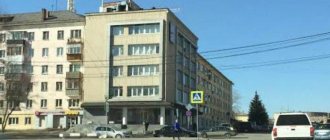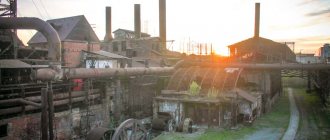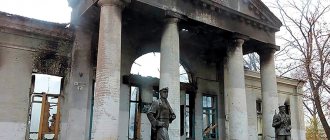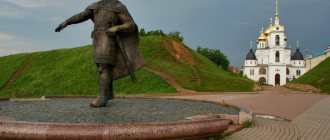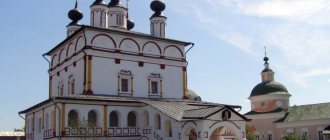Sights of Nizhny Tagil.
Nizhny Tagil is a large industrial city in the Urals. Since the 18th century, the Demidov family, large metallurgical industrialists of the country, had a hand in the development of the city. Nizhny Tagil has made a historical contribution throughout the world throughout its existence. It was here that the frame of the Statue of Liberty in America, T-34 tanks, Russia's first bicycle and the country's first steam locomotive were cast.
The industrial city and its surroundings have many attractions that will interest tourists. We will take a closer look at the names and descriptions of the main attractions of Nizhny Tagil below.
Architectural sights and monuments of Nizhny Tagil
The Cherepanov House is an architectural monument of Nizhny Tagil, where famous inventors once lived. Today this house houses a historical and technical museum, where the father and son Cherepanovs developed the first Russian steam locomotive.
The museum also displays the work of other inventors - astronomical clocks and other engineering innovations.
In the post-revolutionary years, the architectural monument was occupied by various city institutions. And only in 1984, the building was transferred to the Gornozavodskoy Ural Museum-Reserve.
The modern house of the Cherepanovs, after restoration, with a complete collection of works, has been open in Nizhny Tagil since 2004.
A two-story mansion, with openwork balconies, on the shore of a pond with an exciting excursion, will not leave either adults or small guests of the city indifferent.
The Demidovs' mansion was built on two floors, in a classical style with a garden plot where a park was laid out. Today, the restored mansion is the residence of the once manager of the Demidov factories - F.I. Shvetsova.
A museum is opened here in honor of the engineer, where the interior of his life is recreated. The walls of the museum are decorated with portraits of the Demidov family - benefactors of the engineering clan. Exhibitions, advertising shoots, and photo sessions are regularly held here. Local residents and guests of the city love to stroll through the park.
The Khudoyarovs' mansion once belonged to peasants who worked at the Demidovs' enterprise. The Khudoyarov family became famous in these parts for painting trays and kitchen utensils in their own style. The nobles appreciated the work of local artists, so their works were sold abroad.
Years later, local authorities decided to open a museum on the artisans' estate. Where the works of the Khudoyarov family and craftsmen from all over the region are presented.
The monument to metallurgists in Nizhny Tagil was erected in honor of the workers of the metallurgical plant. The monument is depicted in the form of a human biofield, symbolizing the work of metallurgists from the beginning to the present. The sculpture, installed on a pedestal, is made of granite and bronze and reaches a height of 14 meters.
Many tourists rush to take memorable photos with the monument in the background.
The monument to the Red Guards in Nizhny Tagil is symbolically placed in honor of the fierce fighting during the 1918 war. In those years, most of the Red Army soldiers died. And in honor of the memory of their heroism and exploits, a monument was erected in 1957.
The monument bears the inscription “Glory to the heroes of the Civil War.”
Tagil stories. Tagil monuments (part 1)
...Not so long ago it turned out that about 60% of Odessa residents and almost 100% of guests of this glorious city believe that the “Bronze Duke” - a monument to the Duke of Richelieu - was erected in memory of that same treacherous cardinal of France, whom we all know from the novels of Dumas. And only 40% will confidently say that the “Duke of Odessa” is just the great-great-grandnephew of the famous “Red Duke”...
Do all Tagil residents know the monuments of their hometown? Probably the majority. Does everyone know the history of their appearance or the stories associated with them? Most likely no. So, we decided to devote several issues of “Tagil Stories” to our monuments. Without excessive pathos and strain, without chronological, geographical and ideological references.
*** *** *** ...The most famous monument of Nizhny Tagil is, of course, the monument to father and son (and not brothers, as the current Minister of Education D.V. Livanov believes) Cherepanov, erected on the central square of the city by decision Council of People's Commissars of the USSR dated August 22, 1945.
The monument itself was opened on November 4, 1956, and it cost the city 251 thousand “old” rubles. History has preserved the memories of the author of the monument, sculptor A. S. Kondratyev: “When I was offered work on it, I began to study the life and life of the Cherepanovs, the clothes of that time, which immediately made their images concrete.
What is the idea of my monument? Briefly, it is like this: the power of Russian antiquity coming, as it were, from the earth, expressed in the person of Father E.A. Cherepanova is a seated figure, powerfully pointing to the drawing and calling to solve the technical problem... The turn of the head facing her son is a call to the younger generation, which has been given the task of finally solving the technical problem. The standing figure of Miron Efimovich Cherepanov expresses great calm, confidence, perseverance and fortitude...” Here it must be said that the author of the monument, apparently, was filled with local romanticism and was in some kind of delusion regarding the heroes of his creation. According to the testimony of manager Lyubimov, Efim Alekseevich Cherepanov was only considered literate. In fact, he barely knew how to read and by the age of 30, except for the Psalter, he had not read a single book, and from letters he could only sign statements. Subsequently, of course, the number of books he read increased, but, according to contemporaries, he did this with great reluctance. His son Miron did the writing and translations from foreign languages, and his nephew Ammos did the drawings. Therefore, in the scene captured by the sculptor, Cherepanov the father, apparently, simply asks his son to read what is written in the scroll...
In general, there are many legends around the Cherepanovs, but about them some other time.
The people first nicknamed the monument “Two Jews” - the first snowball, which fell shortly after the opening of the monument, covered the heads of father and son with white yarmulkes. But soon, Tagil residents dearly fell in love with the pioneers of the domestic locomotive industry, and changed their anti-Semitic nickname to the familiar “Cherepanovs” and the diminutive “Skulls”. The phrase “Meet me under the Skulls”
can still be heard today...
Two curious facts are associated with the monument to Efim Alekseevich and Miron Efimovich, which over time became urban legends.
Have you ever paid attention to... the faces of father and son Cherepanov? People of the older generation, who carefully looked at the monument to our illustrious fellow countrymen, often began to be overcome by vague guesses: somewhere they had already seen these faces. At least twice a year for sure.
In order to solve this mystery, you need to imagine how members of the Union of Artists mainly earned their bread and butter between large orders in those distant years. And they made money by making busts and sculptures of historical figures that were iconic in those days, including the theoreticians of scientific communism - comrades Lenin, Marx and Engels. The sculptor Kondratiev was no exception. And, either the routine left its mark, or the sculptor simply decided “not to bother” with working with portraits of father and son, but Efim Alekseevich came out looking just like Comrade Engels, and Miron turned out to look like Karl Marx during the “Union of the Just”...
The second story is the legend about the compass that Cherepanov Jr. was supposed to hold in his hand. However, here, from the darkness of centuries, a historical thread appears, connecting the monument to the Cherepanovs with another famous monument of Nizhny Tagil - the first monument to Nikolai Nikitich Demidov in the history of the city. And this thread, no matter how crazy it may sound, passes just through the compass...
...It all started back in 1830, when the sons of Nikolai Nikitich Demidov, Pavel and Anatoly, ordered a monument to their parent from the artist K. J. Bozier in France. Five years later, the monument was ready and sent to the customer. The transportation and installation of the monument in Nizhny Tagil was under the supervision of Father Cherepanov himself, and in May 1837 the monument was installed near the Vyisko-Nikolskaya Church, which was still under construction. A crypt was built at the church, which was supposed to become a tomb for all the Demidovs, starting with Nikolai Nikitich himself, and the monument was supposed to stand at the entrance to this crypt. At the same time, the monument was examined by the future Emperor of Russia Alexander II and his teacher, poet V. Zhukovsky, who came to Nizhny Tagil. They say that it was Alexander who was the first to express the idea that a monument to such a great man should be located on the main square of the plant (and, until 1919, Nizhny Tagil was considered just a plant), and not among the huts of vile people. Eight years later, the Demidovs did just that - they moved the monument to the square between the plant management, the plant and the Jerusalem Entrance Cathedral.
The monument to Nikolai Nikitich turned out to be sophisticated, with the “show-off” traditional for the Akinfiev branch of the Demidov family. On a marble pedestal, surrounded by a cast-iron grille, there were two figures: a kneeling woman in a crown and ancient Greek costume, to whom Demidov, dressed in a court caftan with orders and ribbons, extended his hand. Below this central pair, at the corners of the pedestal, are four bronze groups. The first was a seated woman in ancient Greek clothing and a boy with a book in his hands (Demidov learns wisdom). The second group depicted the same woman, into whose hem a young man pours fruits from a cornucopia (Demidov brings the fruits of his enlightenment). In the third group there was the same woman with a saddened face and Demidov, dressed in a military uniform (Demidov is a defender). The fourth group portrayed Demidov as a patron of the arts, education and trade, who donates something to the same woman. The bronze woman personified, of course, Mother Russia, which, according to the author of the monument and those who ordered it, would have a hard time without Nikolai Nikitich.
However, after several years, one fine day the clerk Belov discovered the absence of some elements from the sculptural group depicting Demidov the student. Namely, books and compasses. The owners were just waiting at the factory, and the missing items were quickly restored. But not for long: a couple of months later the book and compass disappeared again. Out of fright, Belov spread a rumor around the plant that there were Masons in the village. Who else could so brazenly steal a compass and a book from a monument in front of the watchmen of the factory management, the Temple and the factory dam? Only Masons... Young Demidov without a book is like Pinocchio without the alphabet. To avoid further looting of the monument, the manager ordered all the small parts to be twisted from the masterpiece and handed over to the warehouse according to the inventory.
In 1891, when the mining museum was created, these parts were transferred to the museum exhibition. Only the sign of Mercury has survived to this day, as a symbol of trade. The monument itself faced an unenviable fate.
After the October Revolution, in 1919, Nikolai Nikitich and all four allegories were removed and, as made of valuable metal (bronze), sent to Moscow for melting down. They were last seen in the warehouse of the electrolyte plant in the spring of 1923. Tagil museum workers rushed to save the monument, and went all the way to Lunacharsky. But it was too late...
...History repeated itself in 1956, when a monument to the Cherepanovs was unveiled in the city. According to the project, Miron Efimovich should have a compass in his hand, which for some reason could not be cast along with his hand. The compass was cast separately and secured in the hand with a bolt. In the photographs of the monument taken on the opening day and ten days after it, a compass is available...
The legendary compass But, two weeks later, it disappeared. And again the compass! Are they really Masons?.. The city authorities turned to the manufacturers for help, and they cast another dozen spare compasses. However, within two or three years this supply dried up. Unable to cope with the mania of the townspeople, the city executive committee spat on the compass, and the Cherepanovs stood without a compass right up to the present day.
Departure of the Cherepanovs for restoration In the mid-2000s, the head of the city, Nikolai Didenko, decided to restore the monument and, knowing the craving of his fellow countrymen for bronze compasses, he ordered five of them in stock. But after the restoration, the monument was put in place, a video was filmed for local news and, deciding not to tempt the evil one, the compass was twisted, leaving Miron Efimovich without a tool. The general public, for the most part, did not even know about the compass, and therefore this item became an urban legend...
...The second most famous monument in our city is the monument to Lenin, which stands at the foot of the Trade College, and is nicknamed in the world only as “Grandfather on the Ball.”
The monument was opened on November 7, 1925, which you can read about without looking in local history reference books, but by bowing to Ilyich on the floor:
Date of opening of the monument on the pedestal The monument has a rich history. Firstly, this is one of the first monuments to Lenin in Soviet Russia. True, the figure of the leader of the world proletariat itself is nothing special: it is a “park” figure, made in St. Petersburg in a thousand copies, in the year of Lenin’s death. Before the war, our Ilyich’s brothers of the same domain stood in almost every more or less large settlement in Ukraine, Belarus, the European part of the RSFSR and here and there in the Urals. But the pedestal is not just original. In the 30s of the 20th century, it was noted by the future academician architect Vesnin, and they wanted to borrow his concept when designing the building of the Palace of Soviets in Moscow. They say that Stalin himself liked the pedestal. True, it didn’t work out with the Palace of Soviets, but nevertheless...
Secondly, the monument suffered a lot during the perestroika and post-perestroika years. As soon as “it became possible to say everything” in the Soviet Union, the local “sharks of the pen” began to exercise fantasies on the theme of the “monument to the bloody dwarf.” Some wrote that “Grandfather on the Ball” was installed on the site of the former monument to Demidov, and therefore should be demolished “in the name of historical justice.” Others wrote that the monument was erected on the site of the destroyed Cathedral of the Entrance to Jerusalem, and even more so should be demolished.
Both were complete nonsense. The monument to Nikolai Demidov stood a little lower - right in the place where the highway now passes. And the Cathedral of the Entrance to Jerusalem was 20-30 meters higher. Moreover, both “Grandfather...” and the Cathedral managed to stand next door for some time, and the conscious masses of workers did not oppose this at all.
Construction of the monument to V.I. Lenin (photo by unknown author, 1925) Nowadays “Grandfather...” has the status of a historical monument, the area around it is chosen by a few mothers with strollers and even fewer members of the Nizhny Tagil cell of the Communist Party of the Russian Federation. Not long ago, “Grandfather…” had a huge black cross in his neighbors. The initiator of the settlement - the former Dean of the Mining District - erected a gigantic cross on Calvary, supposedly on the site where the Cathedral of the Entrance to Jerusalem once stood. The size of the cross should apparently indicate a change in the spiritual priorities of the townspeople and remind them that the Temple once stood on this very spot. However, when placing a cross on the old plan of the Nizhny Tagil village, you can notice that the cross was placed not on the site of the Cathedral, but next to the church fence, on the place where a hundred and fifty years ago there was a parking lot for horse-drawn transport, the coachmen had a smoke break and their horsepower was restored. Not only was the settler clearly out of place, but for some reason he was painted a radical black color. It is also surprising that the “place of prayer” of the very first church of the Nizhny Tagil plant remained for some reason without the attention of church leaders. Although before the revolution this place was not only marked out by a fence, but also illuminated by a lantern.
"A place of prayer." In the photo on the right (photo by unknown author, early 20th century) Several years ago, the city administration decided to send the leader for restoration. But for some reason this was done secretly from the public. Local historians and communists decided that the monument would be eliminated and came out to a rally. Rumors spread around the city that a monument to either Nikolai Romanov or Boris Yeltsin would be erected in Lenin’s place. And the authorities had to publicly explain to the population that Ilyich simply went to a sanatorium... ...However, in the chronicles of Nizhny Tagil there are more epic stories associated with monuments. For example, the history of a “cursed” place where monuments have not lingered for long for more than a hundred years.
It began in 1895, when, on the initiative of the gentlemen owners of the Nizhny Tagil factories and for some reason at the expense of local residents (unexpected attacks of greed are also a distinctive feature of the Akinfievsky branch of the Demidov family), a monument to Alexander II the Liberator was erected on a vacant lot crossed by Nagornaya Street.
The street, along which houses of Tagil merchants were already being built in full swing, was renamed Alexandrovskaya, and the vacant lot itself was renamed Alexandrovskaya Square. The opening celebrations passed, and no one paid attention to the monument. A market grew on the square, a chapel was built, and the monument was lost against the backdrop of merchant storehouses. And in the first year of the 20th century, the square itself was renamed Bazarnaya.
So the monument stood in half oblivion until 1917. Changes broke out, and the image of the Tsar-Liberator fell out of the concept of the new government. At first they wanted to demolish the monument. But it was not for nothing that the Demidovs taught their people to be thrifty: the smart heads in the Revolutionary Military Council of the Nizhny Tagil factory village decided to remake the monument. We began to look for a sculptor. One of the railway workers remembered the locomotive driver Nikolai Bannikov, who was known among the local people as a self-taught sculptor, and also dabbled in painting and portraits. The commander of the Tagil Red Guard, Pyotr Babin, who headed the local Council, explained to Nikolai the essence of the idea - to rebuild the monument to the Tsar into a proletarian monument. Bannikov thought for a moment and agreed.
The order was urgent, the executive committee did not allocate time for creative search, and Nikolai grabbed the first idea he came across: in one book he saw the American Statue of Liberty, which impressed him with its majesty. It was this option that Bannikov proposed. The authorities agreed: Freedom is our way! And the self-taught sculptor set to work.
The monument lost its cross, a bas-relief depicting Alexander himself, and inscriptions telling about the main events of his reign. Bannikov sculpted Freedom herself - a woman in long clothes and with her right hand raised - at home. It’s not hard to guess who posed for him. In height, Svoboda, of course, was inferior to the American one, but for Tagil it was very good: three and a half meters. The statue was cast to last for centuries - from babbitt, for which a lot of scarce material was used.
The updated monument turned out to be quite complex: Liberty stood on a marble pedestal with a burning electric light bulb in her raised hand; at her feet was a bust of Karl Marx; in one of the semicircles of the pedestal the words were carved: “To the fallen freedom fighters,” and under them a five-pointed star with a hammer and sickle; in the right corner of the fence there was a large fan with three ends of a five-pointed star. A crypt was built under the monument, where the remains of some of the comrades who died in the struggle for the cause of the Revolution were placed. The open monument unexpectedly became popular among the people: various speakers spoke from its pedestal at rallies, and on days free from rallies, couples began to walk here and children began to play.
This continued until the city was occupied by whites. They sent the Babbitt woman to the depot, where they used it to repair steam locomotives, and blew up the monument. Tagilsky Michelangelo was caught by Kolchak counterintelligence officers and thrown into prison. In the dungeons, the brilliant sculptor was seriously beaten, but they did not hang him, but were assigned to the funeral team at the prison. In this position, he met the Red Army units that liberated Nizhny on July 19, 1919.
The most amazing thing is that Bannikov restored the monument! True, due to a shortage of metal, Freedom had to be made of plaster and covered with aluminum powder, but the light bulb in the raised hand burned proudly as before. A year later, Nikolai Bannikov died, and his creation stood for another ten years.
The market on the square had been liquidated by that time, and trees and shrubs were planted on the vacant acres through the efforts of Tagil breeder Kuzma Osipovich Rudov. Against the backdrop of the young square, the monument looked much more decent and harmonious...
...In 1931, the monument was demolished in order to erect a monument to Stalin in its place. The Father of Nations looked sternly around, standing in an open overcoat on a large cubic pedestal.
The square in front of it was converted into a park, supplemented with a fountain and concrete sculptures of pioneers with bugles and Komsomol girls with oars, which is why this place began to be called either Pioneer Square or Komsomol Park. People did not give the monument a nickname. For obvious reasons...
...Khrushchevism came and, in the cold summer of 1956, Stalin was removed from the pedestal, and a Komsomol member with an oar was temporarily stuck in his place. But a few days later the idea was recognized as kitschy, and the rowing goddess was lowered to earth. And then they dismantled the pedestal. By the way, the goddess was sculpted from a real girl, Komsomol member, accountant of the Tagil canteen trust Laura Kulagina.
The area where the monument stood was covered with crushed stone, fenced off with curbs, and a huge stone was installed in its center, on which a sign soon appeared: “A monument to the first pioneers of Nizhny Tagil will be erected here.”
.
The sign apparently resolved a long-standing dispute: “Pionersky” is a public garden or “Komsomolsky”. The tablet itself did not last long for the same reason as the Cherepanovs’ compass. And five years later the stone also disappeared. For some time the holy place was empty. But the stone returned. A new sign on it informed the curious that “A monument to the first Tagil Komsomol members will be erected here
. It is unnecessary to clarify what happened to the sign - the townspeople sacredly honored the centuries-old traditions, and the stone stood for many years until it became clear that the monument to Komsomol members would be erected in front of the Sovremennik cinema. The city authorities announced that a monument to miners, or metallurgists, or someone else would be erected in place of the stone, but this time there were no signs...
...In the early post-Soviet period, the place fell into complete desolation. The stone was gone, and either garbage containers or trailers of workers were placed on the site, who were endlessly building an underground garage opposite. Slowly the winds of change calmed, and in the late 90s the mayor of the city announced that a monument to the Demidovs would be erected at this legendary place. For several years, the greatest minds of the city decided who exactly the monument would be erected - the entire dynasty or just one. The decision was made, as always, behind the scenes, and on October 9, 2007, the opening of the monument to Nikolai Nikitich Demidov took place. True, when they started digging a hole for the foundation. a passage happened: under a layer of rubble and earth, the remains of the first two monuments that stood in this place were discovered. Museum workers demanded that the cultural layer be preserved, and officials had to carry the wreckage of the two empires to the museum storerooms in their Mercedes.
The monument was erected, and on the opening day some local wit called the bust “Nikolai Naumovich Demidov.” But among the people, a different nickname was assigned to the new monument - “Chupa Chups”...
Nikolay Naumovich Demidov aka “Chupa-Chups” ... The path of the sculptor-machinist Bannikov was recently followed by the responsible persons of school No. 9, unknown to the author, on Vagonka. True, they never had the talent to sculpt. It turned out that this is not necessary for creativity. It is enough to install a new sign on the already finished monument. Pseudo-Makarenko At first glance, it is clear that the man in concrete looks like Makarenko, like a platypus looks like a hyena, but the sign on the pedestal encourages you to believe the opposite. A. S. Makarenko Your humble servant, who studied at school No. 9 for all ten years, can swear that this bust during the years of “stagnation” was a monument to the fighter pilot, three times Hero of the Soviet Union, Alexander Ivanovich Pokryshkin. It would not hurt for the school’s teaching staff to know that the school’s pioneer squad was named after Pokryshkin, that on Victory Day the students laid flowers at the foot of the monument, and that Alexander Ivanovich himself was in correspondence with the school’s pioneers. You can also google a bunch of photographs of the thrice Hero of the Soviet Union, and by visual comparison make sure that this is not Makarenko.
A. I. Pokryshkin (left) But, either the resources of the World Wide Web are still inaccessible to the creatives of school No. 9, or the desire to bend to various ITs has overshadowed the memory, but the fact, as they say, is obvious...
...In general, we can talk about monuments in Nizhny Tagil for a long time. Some of them are known outside our city, some are undeservedly forgotten, some are examples of militant idiocy.
Not long ago they started talking about installing another monument in Nizhny - a monument to Okudzhava. Despite the fact that there is no reason to erect a monument to Bulat Shalvovich in our city, it will not be superfluous: whatever one may say, this is our history. The main thing is that the flight of creative thought of the sculptor does not spoil the reputation of the monument, as happened with the monument to the poet on Arbat.
Monument to Okudzhava on Artbat The fact is that after the rain, a puddle forms under the figure, which, together with the pose of the poet, makes the viewer think that not everything is rosy with public restrooms in the capital... *** *** *** Theme of Tagil We will definitely continue to build monuments.
But first, let’s introduce an element of interactivity into our section. The Reader has a week to ask the author a question about our monuments. The answers to these questions will form the next issue of Tagil Stories. (to be continued)
Cultural attractions of Nizhny Tagil
The Nizhny Tagil History Museum was opened in 1963, in an ancient factory building. Taking a tour of the museum, you will see 3 workshops that were the first to produce metal in the entire union. The workshops have been operating in the city since 1725.
Important! It is worth remembering that museum buildings should only be visited accompanied by a professional guide! Self-guided tours can be dangerous! Therefore, it is worth contacting local guides.
The Nizhny Tagil Museum of History and Local Lore was built in 1833; in 1841, N.P. Demidov opened the “Museum of Natural History and Antiquities” here. In the post-revolutionary period, the building was occupied by the city administration, but since 1924 the building was returned to the city museum.
The main exhibitions of the museum are the interior decoration, floor slabs and a cast iron staircase. The museum introduces its visitors to the history of mining ore and the development of industry, from its opening to the present day.
The Nizhny Tagil Nature Museum presents collections of remains and skeletons of ancient animals, including mammoths. There are also collections from local attractions: malachite, rock crystal, jasper, gold, platinum.
Thousands of exhibits of flora and fauna of the local region await tourists and city guests.
The Museum of Fine Arts in Nizhny Tagil has been open since 1944, in an ancient building of a merchant's house and warehouses. Today, about 10,000 exhibits of Russian and foreign artists are presented here.
They also regularly hold exhibitions of local artists, children's art, and sculptors. The first works of local sculptors appeared in the city in 1806, from the time of the art school, which was opened by Demidov. Every tourist and guest of the city can see the works of the local region.
The Museum of Everyday Life presents in its exhibitions household items, household utensils, tools, and agricultural items. The museum staff will give you a tour of traditional rituals and the culture of the Tagil region.
The Mamin-Sibiryak Drama Theater is the first theater in the city, opened in 1862. The theater is distinguished by its diverse repertoire. Dramatic plays and comedies await all art lovers. And the luxurious foyer, marble staircases, stucco moldings and paintings, along with 250 lamps illuminating the hall, will not leave any viewer indifferent.
Shrines of Nizhny Tagil
The Holy Trinity Cathedral was built of stone in 1872, on the site of a wooden church. With the advent of Soviet power, the temple was closed, and its building was used as a warehouse, workshop, and garage.
Since 1991, the temple was returned to believers, and a long reconstruction began. After reconstruction, the temple acquired a new look, and the doors of the shrine are open to all believing parishioners.
The Alexander Nevsky Temple was erected in 1877 in honor of the abolition of serfdom. Thus, local residents tried to thank Tsar Alexander 2. The shrine was erected over the course of 16 long years.
The temple is located on Veresovaya Mountain, offering an incredible view of the city. The majestic and harmonious temple is the pride of local residents, which all tourists and guests of the city are in a hurry to visit.
The Cathedral of the Kazan Icon of the Mother of God has been consecrated in Nizhny Tagil since 1872. This is the only temple in the city that continued services during Soviet rule. Since then, the cathedral has added a couple of thrones, and its shrines have been replenished with particles of the relics of John Chrysostom, Gregory the Theologian, St. George the Victorious, etc. Thousands of tourists come to lean against them every year.
Harvest July
July turned out to be fruitful for historical finds: these are the remains of the destroyed monument to the “Fallen for Freedom” of 1918 (reconstruction of the monument to Alexander II built in 1895) and the foundation slab of the Avrorin shelter from 1857.
Details of the monument to those who fell for freedom were discovered on July 13 this year in the evening during construction work (they are being carried out by Tagildorstroy) to build the foundation of the monument to Nikolai Nikitich Demidov in Komsomolsky Square. It was founded in 1992.
The history of the discovered monument goes back centuries.
Originally it was a monument to the Russian Emperor Alexander II the Liberator. The monument to Alexander II was built with funds and on the initiative of Tagil residents in 1895. Installed on the main shopping square, Nizhny Tagil - Bazarnaya, which stretched from Aleksandrovskaya Street (now Lenin Avenue) to Shamina Street (now Karl Marx Street) and from Balykovsky Lane (now Ogarkova Street) to Vysokovskaya Street (now Pervomaiskaya Street).
Money for the construction of the monument was collected in memory of the stay of the heir to the throne, Tsarevich Alexander, the future Emperor Alexander II, in Nizhny Tagil in 1837.
Monument to Alexander II. 1895
The monument was surrounded by a stone wall. A wide stone staircase led to it. The height of the monument's base was approximately 5 meters. The monument looked like a pyramidal chapel made of gray marble, topped with a cross. On the western side of the monument, in a niche under the arch, there was a bas-relief of Alexander II, under it the state coat of arms - a double-headed eagle, in its paws there was a scepter and an orb, and the inscription: “Emperor Alexander II.” Above the bas-relief on the arch there was an inscription in a semicircle: “My people, what has He done to you, even if you repay evil for good.”
Several attempts were made on the emperor's life. In March 1881, Alexander II was mortally wounded by a bomb thrown by Narodnaya Volya member I.I. Grinevitsky.
The main act of Emperor Alexander II in domestic politics was the liberation of peasants from serfdom in 1861, as well as zemstvo and judicial reforms, reforms of public education. Alexander II pursued an active foreign policy - the Amur region and Tashkent were annexed to Russia, Bessarabia and Armenia were returned, the Bulgarians and Serbs were liberated during the Russian-Turkish war of 1877-1878. Let us also remind readers that in the second half of the 19th century, Nizhny Tagil was going to be renamed Alexandrovsk in honor of Alexander II.
The monument to Alexander II stood in Nizhny Tagil until 1918, then it was reconstructed and on its basis the monument “Fallen for Freedom” was created according to the design of the first Tagil Soviet sculptor Nikolai Aleksandrovich Bannikov. He was a self-taught sculptor and worked as a locomotive driver at the Nizhny Tagil station.
On a marble pedestal, instead of a cross, stood a 3.5 m Statue of Liberty with a burning light bulb in her raised hand. The Statue of Liberty in New York was taken as a model. On the western side of the monument, in place of the imperial crown, there was a bust of Karl Marx, and on the arch were carved the words: “To the fallen freedom fighters.” In the niche of the monument there is a five-pointed star, a sickle and a hammer. The monument and the square in front of it, called “Freedom Square,” became a favorite venue for rallies.
The Statue of Liberty was originally made of plaster, and after the statue was destroyed during the occupation of Nizhny Tagil by the White Guards in 1919, it was again restored from babbitt (a metal alloy).
Monument to those who died for freedom. 1918
The White Guards restored the cross and crown on the monument, and Bannikov was thrown into prison. A seven-month imprisonment shortened the sculptor’s life: Bannikov died in 1920 at the age of 42, having managed to restore the statue from the surviving forms.
According to the memoirs of local historian A.F. Kozhevnikov, five Red Army soldiers were buried under the slabs on the eastern side of the monument, including the first chairman of the Nizhny Tagil Council D.N. Dobrynin and Jan Ermiusz, who died in Chernoistochinsk in 1918. Nearby, 13 more Red Army soldiers who died in September 1918 were buried under the chapel. When Nizhny Tagil was captured by the White Guards, the bodies of the Red Army soldiers, according to the memoirs of A.N. Slovtsov, were removed from the crypt and reburied in the cemetery on Malaya Kushva.
In 1931, on the site of the monument to “Fallen Freedom Fighters”, a monument to I.V. was erected. Stalin. Joseph Vissarionovich, standing in an open overcoat on a cubic pedestal, proudly looked at the prospect of the streets of Tagil that opened before him. It was quietly dismantled in 1956.
Monument to Stalin. 1931
The cast-iron foundation slab of the Avrorin shelter was discovered on the territory of the shopping mall under construction also this year, on July 10, and the next day was transferred to the museum. The building of the former Avrorinsky shelter in Nizhny Tagil, now located on the territory of the Interregional Training Center for Signal Corps, is a monument of history and architecture of the mid-19th century, built according to the design of the outstanding Ural architect A.Z. Komarova (1793 -1857). The Avrorinsky orphanage was established in 1849 with funds from Aurora Karlovna Demidova-Karamzina, one of the co-owners of factories in the Nizhny Tagil district from 1841 to 1904.
On behalf of the museum staff, local historians, and the Tagil public, I would like to thank the builders - the leaders and direct participants of the find - for understanding the historical significance of the monuments and caring for them. This once again demonstrates that Nizhny Tagil is a city of high culture.
We can confidently predict that the unique finds discovered during construction work in the historical part of the city are far from the last. The Tagil land has not yet revealed all its secrets...
Tatiana SMIRNOVA.
Literature: Newspaper “Tagilsky Rabochiy” dated July 25, 2007.
Fragments of a monument to Emperor Alexander II found
The fourth monument is being erected in the same place...
In the center of Nizhny Tagil, the remains of a monument to Emperor Alexander II, destroyed in the 30s of the last century, were discovered.
The first wreckage was found on Friday, July 13, 2007. The debris was found by builders while preparing the area for the installation of a monument to Nikolai Demidov on a historical site in Komsomolsky Square opposite the Severny Ural Hotel. Currently, 27 different-sized fragments of the composition made of gray marble have been discovered.
The Committee on Architecture and Urban Planning decided to preserve the historical find. All fragments of the old monument will be taken to the territory of the Demidov museum-factory, where a place will be assigned for them in the general exhibition. And in Komsomolsky Park, as planned, in honor of the 285th anniversary of Nizhny Tagil, a monument to Nikolai Demidov will appear.
The monument to Alexander the Liberator, erected with funds and on the initiative of Tagil residents, appeared on the main street of the city (Alexandrovskaya, now Lenin Avenue) in 1895. It was installed in memory of the stay of Emperor Alexander II in 1837 in Nizhny Tagil and looked like a pyramidal chapel made of gray marble. The laying of the monument, built at the expense of the townspeople, took place on August 30, 1891, and the opening took place in 1895. The monument was located on the city's Market Square (currently a square opposite the Northern Ural Hotel). During the Civil War, a new one appeared on the site of the monument in honor of Emperor Alexander II: the Freedom Monument, built according to the design of N.A. Bannikova. Under its stone foundation, the first heroes - the Red Guards - were buried with appropriate honors. Then a statue of Lenin was erected at this place, then of Stalin. When the cult of personality was finished, the pedestal was demolished along with the figure of the “father of all nations.”
A bronze bust of the breeder, one meter and seventy centimeters high, will be placed on a four-meter granite pedestal in Komsomolsky Square, where the foundation of this monument took place back in August 1992. The total weight of the sculptural composition will exceed 15 tons. The cost of the monument, according to preliminary estimates, will be over 4 million rubles. The area around the composition will be lined with ancient paving stones.
Press service of the City Administration. 07/17/2007.
Home page


